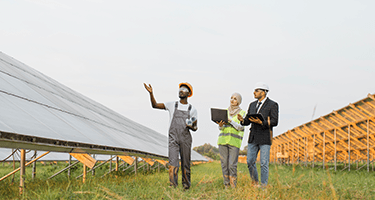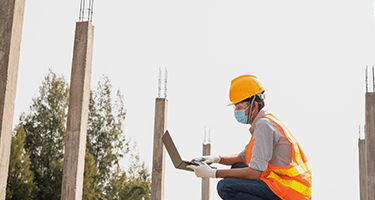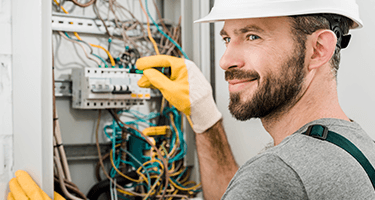6 Types of Future Technology for Construction Professionals
According to Deloitte’s 2021 engineering and construction industry outlook, 76 percent of engineering and construction executives indicated that they are planning to invest in digital technology this year. Investing in the latest construction technology is helping business owners facilitate digital transformations and stay a step ahead of the competition. Modernizing your current construction processes have real, practical applications and benefits. And if your construction company wants to maintain a competitive edge, you’ll need to find ways to integrate new approaches into your strategy and workflows. These cutting-edge technologies are drastically changing how the industry operates and how future projects will be completed.
Construction Technology Solutions
1. Data Collection Apps
Apps are becoming more of the norm in construction and for a good reason. The increased portability of tablets, smartphones, and other new technologies allows for greater communication between construction teams and the ability to work from anywhere. More specifically, data collection apps are helping construction companies gather faster, more accurate, and higher quality data from the jobsite. Integrating this type of technology into your current project management processes is simple. It equires a smaller upfront investment while still providing major benefits, including:
- Significant time savings & reduced data entry errors. Data collection app users have reported more than 20 field and administrative hours saved each week, along with a 50 percent reduction in data entry errors. Helpful tip: Estimate your ROI potential by using our free online calculator.
- Enhanced workflows. You can automate data collection workflows, so the submission of one form triggers another form to be sent, and so on, until a particular task is completed with all necessary sign-offs and collected data. Additionally, some data collection applications offer mobile forms and web forms apps so your team can submit forms on their smartphones, tablets, laptops, desktops – basically any digital device.
- Improved safety compliance. Data collection apps can facilitate everything from daily equipment inspections to near-miss reporting to a comprehensive job safety analysis.
Instant reporting. Whether you need daily job reports, quick turn-around on client deliverables, or fast access to legal documentation, a data collection app is going to help you streamline reporting. You can also easily customize reports based on your business needs.
2. Drones and Robotics
Drones are the most widely used emerging construction technology. They can conduct site surveys more quickly and accurately than a crew on the ground and are cheaper than aerial imaging. Their high-resolution cameras and the data collected can create interactive 3D or topographical maps and models, and take volume measurements.Another benefit of using drones is the ability to inspect hard-to-reach places such as bridges or around tall buildings, and to do it safely. You can also use them to monitor progress on a job site and see how people work.
3. Building Information Modeling (BIM) Software
The use of BIM provides space for better collaboration because each person and expertise area can add their piece to the same model, instead of breaking out onto multiple versions of a 2D paper drawing. This way, the model evolves immediately as people contribute, streamlining the process and increasing efficiency. BIM also helps with problem-solving in the design and planning stages of a project, by automating clash detection and providing a more complete picture of the project. We’re seeing more and more global government initiatives to make BIM a compulsory procedure for large-scale facilities projects, including in India, Hong Kong, France, South Korea, Germany, and Italy. In the United Kingdom, BIM is already mandatory for government construction projects. According to Research and Market’s 2021 Building Information Modeling Market Report, emerging trends that will have a direct impact on the industry include AI development in BIM, increased demand for BIM-based cloud collaboration, and modular construction and prefabrication.
4. Virtual Reality and Wearables
Virtual reality technology is often used in conjunction with BIM to help better understand complex projects. Think of the potential: you create a building design with BIM and then are able to use VR to actually walk around it. Pretty cool, right? This will give your team, or the client, an even more realistic idea of what the project will look like once completed. Having a more complete grasp on the project before it begins gives you the opportunity to avoid big changes and expensive change orders mid-way through. Wearables are a construction technology that is not only making a positive impact on safety, but also productivity. AsphaltPro published a recent article on the topic, reporting that wearable technology in the construction industry can increase productivity by 8.5 percent and workplace satisfaction by 3.5 percent. The article also highlighted some notable products on the market, including XOEye Smart Glasses, Spot-r Wearable Sensor, and Redpoint Positioning Safety. Vest Sensors
5. 3D Printing
3D printing as a construction technology has the potential to change material sourcing. For prefabrication, materials for a project can be printed and then transported to the job site, ready for use immediately. This can allow you to get materials faster and streamline the process by removing extra steps in the middle.3D printing makes it possible to print materials right on site, reducing waste and further saving on transportation and storage costs. However, one of the current challenges with the adoption of this technology is limitations with mass production. Although some 3D printers can produce on a larger scale, they are expensive.
6. Artificial Intelligence
For years, artificial intelligence (AI) has provided benefits to construction projects through increased safety, improved workflows, and get jobs done faster and better. However, many construction companies continue to navigate and learn how to best apply this complex technology within their organization. Some larger firms have started to build out their own AI programs to help with internal decision-making processes and operations. While others are relying on third parties, such as AI advisors and solutions providers, to audit their current practices and identify opportunities for AI and/or machine learning implementation.
Investing in Construction Tech Tools
Investing in the latest construction technologies is undoubtedly a smart business move. The key is finding the tech tools to help you reach your company’s goals. As we mentioned earlier, onboarding a data collection app is a good place to start your digital transformation. At GoCanvas we provide a vast variety of templates to help you create the best project management apps for your construction site. Contact us today to learn more.

Stay in Touch!
About GoCanvas
GoCanvas® is on a mission to simplify inspections and maximize compliance. Our intuitive platform takes care of the administrative tasks, freeing our customers to focus on what truly matters – safeguarding their people, protecting their equipment, and delivering exceptional quality to their customers.
Since 2008, thousands of companies have chosen GoCanvas as their go-to partner for seamless field operations.

Check out even more resources

The Ultimate Guide to Quality Control Inspections
Managing a construction project is a complex and stressful process. Among other things, you have to coordinate project team members, materials, and equipment and ensure that contractors are not afflicted by the potential risks and hazards present at the construction site. That said, quality means different things to different people which is why you should…

Constructions Digital Transformation
Your competition is finding faster ways to capture data and get critical insights from the field into their existing systems. In short, they’re not going bigger, they’re getting smarter. In this 15-minute broadcast on the construction industry’s digital transformation, find out why the trend is to modernize workflows – and how you can stay ahead of the curve…

See how VIP Lighting optimized efficiency with GoCanvas
VIP Lighting is a retail lighting and electrical maintenance business that services over 10,000 retail locations all over Australia and New Zealand. Before GoCanvas, VIP Lighting had two separate systems that were impossible to integrate, leading to inefficiencies. GoCanvas made it easy to integrate their systems into single, centralized platform…